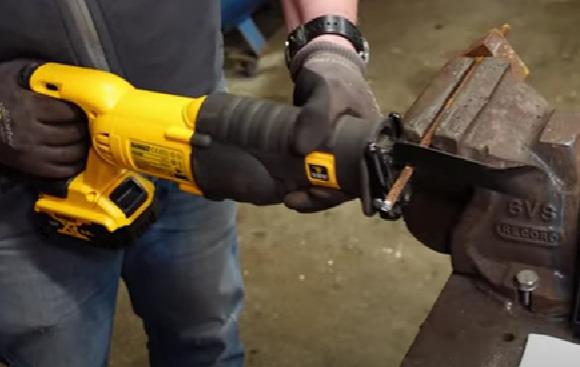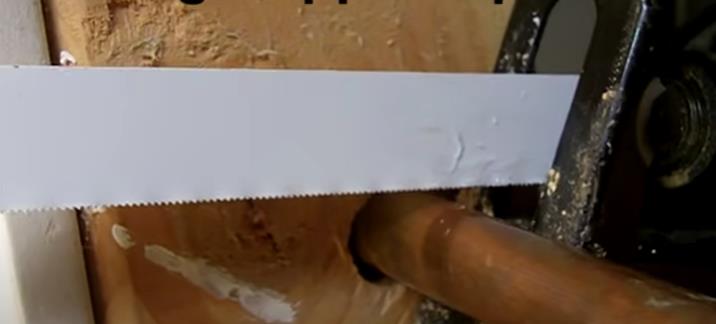Use a blade that is meant for cutting metal.
Can I cut metal with a reciprocating saw? The answer is yes. Find out more about the process and what tools will give you the best results in this article.
Cutting metal can be hard, and you need special tools and skills to make sure the cut is clean and accurate. A reciprocating saw is a versatile tool that can cut many different types of metal. Reciprocating saws can cut through metals like brass, copper, aluminum, mild steel, and stainless steel with ease.
A reciprocating saw can help you get the job done quickly and easily, whether you’re cutting metal pipes for a plumbing project, cutting aluminum for a DIY project, or cutting steel for a construction project.
However, metal cutting necessitates a little more knowledge and equipment. Understanding how to cut metal with a reciprocating saw is a valuable skill to have, whether you’re a do-it-yourself enthusiast or a professional tradesperson. So, get ready to discover your reciprocating saw’s full potential and versatility.
Can I Cut Metal With A Reciprocating Saw?

Yes, a reciprocating saw can be used to cut metal. A reciprocating saw is a versatile tool that can be used for a variety of tasks, including cutting metal. A reciprocating saw can cut through a variety of metals, including soft metals like aluminum and copper and harder metals like steel. The thickness of the metal will impact the ease of the cut and the type of blade required.
When cutting metal with a reciprocating saw, it is important to use the correct blade. A metal-cutting blade will have teeth that are specifically designed for cutting metal. It is also important to use a lubricant when cutting metal, as this will help prevent the blade from overheating. If you are cutting metal that is thicker than 1/8 inch, it is best to use a blade with at least 24 teeth.
For thinner metal, a blade with 18 teeth will suffice. When cutting, be sure to use a slow and steady motion. If the metal is too thick for the blade you are using, it will cause the blade to overheat and break.
Advantages of Using a Reciprocating Saw to Cut Metal
One of the primary benefits of cutting metal with a reciprocating saw is its versatility. This tool can make straight, curved, and angled cuts, making it an excellent choice for precision cutting projects. Furthermore, a reciprocating saw is portable, allowing you to transport it to different job sites, making it a valuable tool for on-site metal cutting.
Factors to Consider When Cutting Metal with a Reciprocating Saw
Before using a reciprocating saw to cut metal, it is critical to consider factors such as the thickness of the metal, the type of metal, and the desired outcome. A more vital saw and a specialized blade are required for thicker metals, whereas softer metals can be cut with a standard blade. It is also essential to consider the saw’s speed and stroke length, as these will affect the cut quality.
How To Cut Metal With a Reciprocating Saw?
To cut metal with a reciprocating saw, follow these steps:

Preparation:
Before cutting, ensure you have the proper safety equipment, such as gloves and eye protection. Secure the metal to keep it from moving during the cutting process, and use a pencil or cutting guide to mark the cutting line.
Choose the Right Blade For Cutting Metal:
To achieve the desired results, it is critical to select the appropriate blade for the task at hand. The type of blade used to cut metal affects the quality of the cut and the speed with which it can be made. For thicker metals, you should use a blade made for cutting metal. For thinner metals, you can use a regular blade.
Marking the Metal for a Precise Cut:
A precise cut will not only make the finished product look better, but it will also make it less likely that mistakes will be made and material will be wasted. To ensure a precise cut, mark the metal before beginning the cutting process. This can be accomplished with a ruler, pencil, or specialized cutting guide.
Adjust the Speed and Stroke Length:
A reciprocating saw’s speed and stroke length can be adjusted to meet the needs of the cutting task. Slower speeds and longer stroke lengths may be required for thicker metals, while faster speeds and shorter stroke lengths can be used for softer metals. By trying out different settings, you’ll be able to figure out the best speed and stroke length for your project.
Maintain a Firm Grip:
Proper grip and control are critical when using a reciprocating saw to cut metal. By keeping a firm grip on the saw, you can reduce vibrations and make cuts that are smoother and more accurate. Keeping control of the saw will also help prevent accidents and keep you and other people in the area safe.
Finish the Cut:
Start the saw and allow it to do the work. To make a smooth and clean cut, avoid using too much force and keep a steady pace. Turn off the saw and remove the blade once the cut is finished. Remove all metal shavings and debris.
Always use caution and safety precautions when using a reciprocating saw to cut metal.
What Are The Different Types Of Reciprocating Saw Blades?
There are three types of reciprocating saw blades: wood, metal, and all-purpose.

As I’ve already discussed can I cut metal with a reciprocating saw, let’s take a look at the reciprocating blades. A reciprocating saw is a versatile tool that can be used for a variety of projects. The different types of reciprocating saw blades allow you to choose the best blade for the job at hand.
There are three main types of reciprocating saw blades: wood, metal, and multi-purpose.
- Wood blades: These are designed for cutting through wood and wood-based materials. They typically have a narrower body and fewer teeth than metal or multi-purpose blades.
- Metal blades: Metal blades are designed for cutting through metal. They typically have a wider body and more teeth than wood blades.
- Multi-purpose blades: These are designed for cutting through a variety of materials, including wood, metal, and plastic. They typically have a medium-width body and a moderate number of teeth.
When choosing a reciprocating saw blade, you should think about the material you want to cut and how thick it is. For example, a metal blade is not necessary for cutting through thin sheets of wood. A multi-purpose blade may be a better choice for this type of project.
If you are working with thicker materials, such as a piece of lumber, a metal blade may be a better choice. The extra width and teeth will help you to cut through the material more easily.
No matter what type of reciprocating saw blade you choose, be sure to read the manufacturer’s instructions before use. This will help you to understand the proper way to install and use the blade.
What Types of Metal that can be Cut with a Reciprocating Saw?
A. Soft Metals:
Aluminum and other soft metals can be cut with a reciprocating saw and a fine-toothed blade. This blade is made to cut through soft metals quickly and efficiently, leaving a clean cut.
B. Hard Metals:
Hard metals, such as steel, can be cut with a reciprocating saw equipped with a hard metals-specific blade. This blade is made of high-carbon steel and is designed to withstand the rigors of cutting tough, hard metals.
C. Thick Metals:
Thick metals, such as pipes, can also be cut with a reciprocating saw, but a specialized blade and faster cutting speed are required. When cutting thick metals, a blade with a high tooth count is essential for quick and efficient cutting without bending or breaking the blade.
These are just a few of the different types of metals that are available. Each has its own unique properties that make it suitable for specific applications.
FAQ
What Are The Different Types Of Saws?
How Do I Know What Type Of Blade To Use For Cutting Metal?
For thin pieces of metal, you can use a hacksaw blade. For thicker pieces of metal, you’ll need a blade that can handle more force, like a reciprocating saw blade. And for cutting at angles, you’ll need a jigsaw blade.
Final Words
A reciprocating saw can be a useful tool for cutting metal, but you need to think about things like the thickness and type of metal, as well as the result you want.
By following the necessary safety precautions, choosing the right blade, and adjusting the speed and stroke length appropriately, you can achieve successful results when cutting metal with a reciprocating saw. Experiment with different techniques to find what works best for you and your project.
Hopefully, you’re all clear about your search topic, “Can I cut metal with a reciprocating saw?” If you have any questions, please comment below.


10 thoughts on “Can I Cut Metal With A Reciprocating Saw? The Ultimate Guide”
Comments are closed.